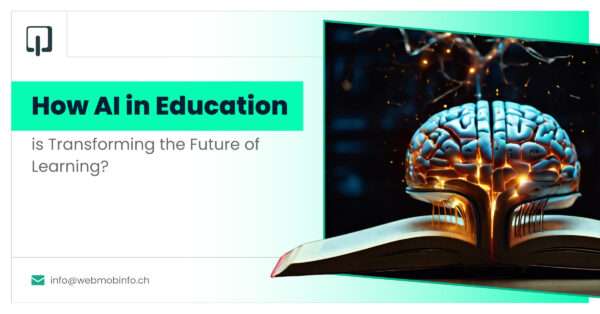As advanced technologies continue to transform almost all fields, education has not been left behind by advancements in artificial intelligence (AI). As the concept of digital learning is being actively implemented in schools, universities, and other educational organizations around the world, the importance of AI as a key driving force for changing the educational environment is growing. These ideas range from individual student’s learning needs to how an institution operates and how it can make education better for everyone. In this blog, we’ll look at what AI in education is, what it is used for, how it can help, examples of its application, and what we might see in the future.
TABLE OF CONTENT
The Growing Role of AI in Education
AI is no longer a fad in education, but rather a new way of how education is delivered. It is a fact that with AI support, one can process a significantly large amount of data and get new data analysis options. AI in Education makes it easier for the educators to adopt teaching strategies that suit the students, hence improving the learning process.
Furthermore, the integration of generative AI services in education is creating other opportunities for creativity and innovation. Starting from the creation of personalized content to AI-simulated reality, educators have been able to become more interactive and relevant. Over time, the use of AI in Education will increase too, which is why it is already considered an essential part of the current classrooms.
Use Cases of AI in Education
AI is revolutionizing education by incorporating solutions that address different features of education. Below are some of the most impactful use cases of AI in Education where AI is making a significant difference:
1. Personalized Learning
AI makes learning personalized since educational content will be made to suit the student, the rate at which the student studies, and the kind of learner the student is. With the help of AI-based programs, students get individual assignments and tasks that they are good at, as well as the tasks that they have difficulties with, which makes it easier for the students to progress at their own pace and within their limits. This way, it is possible to help students who might have challenges coping with normal classroom learning and teaching techniques, thereby helping them excel academically.
2. Virtual Classrooms and Tutors
Over time, technology has become handy, especially in the way classroom lessons are conducted, using virtual classrooms and AI tutors. These tools ensure that the students can access learning material and get help from any part of the world at any time. Using AI tutors, students can easily get help, ask questions, and receive explanations when dealing with difficult material, which enhances students’ learning experience. In this regard, this flexibility is very advantageous to students who are distance learning students and those who require extra guidance in the evening or during the weekend.
3. Smart Content Creation
AI is also being used to develop smart content for a better learning experience for students and faculty. For instance, it can create quizzes and flashcards together with study guides using the content of the course to give students a chance to review important concepts. Moreover, it can assist in building learning games and virtual experiments that would enable the students to practice what they learn since practice is important, especially for science and engineering courses.
4. Administrative Efficiency
Educational management has also been enhanced, whereby the use of AI minimizes paperwork to enable the staff to spend most of their time teaching. Some tasks like grading, keeping records of attendance, scheduling, and even proctoring can be done by the application of the artificial intelligence system thus easing the workload on the educators. This is not only time-saving but also avoids errors that could have been made by people thus increasing efficiency in the schools and universities.
5. Curriculum Planning
Curriculum development is supported by AI since the system can gather data regarding the student’s performance, the patterns of learning, and the industry requirements. Educational organizations can employ AI to develop curriculums that meet the current job market needs so that the students graduating from the institutions will be relevant in the market. AI can also be used in the improvement and modernization of curriculums in an organization to ensure the curriculums are relevant to the current technological developments and society.
6. Customized Data-Based Feedback
AI can give individualized feedback to students based on their performance records. Such feedback is usually more concrete and specific than what a student can receive from his or her teacher. With reference to the test results, assignments, and learning behaviors AI can determine which students may be having difficulties and what should be done to help them. By using this approach, the student can receive data on his or her performance and make changes to enhance the understanding in subsequent lessons.
7. Closing the Skill Gap
Employability skills mismatch is one of the most significant issues in education today due to the difference between what is taught and what is demanded in the job market. AI comes in handy in the process of closing this gap by ensuring that the content being taught in school is relevant to the market. It would also be possible for AI-driven platforms to detect trends in different fields and recommend the right courses or certifications for the students. This helps in ensuring that students are not only taught but also equipped with what they need in the workplace upon their graduation.
Benefits of AI in Education
The integration of AI in education offers numerous benefits, some of which are already being realized:
- Enhanced Learning Outcomes: With AI, students get the reinforcement they require when they need it since education is not a ‘one size fits all’ approach. This makes it easier for the student to deal with learning difficulties and, hence, makes better performance.
- Greater Accessibility: AI can break down barriers to education by providing information in different languages, forms, and complexity levels. This makes education more accessible to students with special needs, including those with disabilities.
- Improved Student Engagement: Various applications including game-based and simulation-based learning systems make learning easier and more fun. Using features of play and competition enables the students to be more involved in learning hence developing a love for learning through the tools.
Real-World Applications of AI in Education
Several institutions and companies are already leveraging AI in Education:
1. Duolingo
Duolingo, an online platform for learning languages, employs artificial intelligence in the way it teaches its users. The learning platform adapts the level of challenge on the exercises according to the performance of the learner to make users feel challenged but not overwhelmed. This has made it one of the most used language learning applications in the world due to its ability to personalize the applications based on the users’ needs.
2. Carnegie Learning
Carnegie learning has AI-based math tutoring software, which can learn the pace at which a particular student learns. The software gives feedback on each problem and tailored exercises to make the students gain confidence in solving the mathematical problems. This approach has especially been effective in increasing and enhancing the performance of students, especially in areas of difficulty such as algebra.
3. Coursera
Coursera is another online learning platform that uses AI to suggest the courses that one should take depending on his/her interests, objectives, and learning preferences. Because of millions of users, Coursera AI algorithms can predict the courses that learners may find useful and help them in terms of education.
AI Solutions for Educational Challenges
AI is well-positioned to tackle some of the most pressing challenges in education:
1. Managing Large-Scale Data
The school collects huge amounts of data daily, ranging from students’ performance to administrative data. It can then help in analyzing the data and get insights into trends and probable occurrences within a certain time frame. This capability is useful in enhancing student performance and organizational effectiveness.
2. Reducing Educator Workload
The class sizes are big, and the students are so diverse in their learning abilities that it becomes a challenge to attend to all the students. AI solutions can assist with work by performing such tasks as grading and tracking attendance. This frees up the time that a teacher may otherwise be spending on clerical work so that he or she can attend to the meaningful tasks of teaching, which include student tutoring and motivation.
3. Enhancing Student Support
In addition to the classroom, AI can offer more assistance to the students. Synchronous computer-aided instruction in the form of virtual tutors, chatbots, and apps can help students do homework, respond to questions, and give explanations. Such support aids the students in their endeavors and ensures that they do not struggle in their academics.
The Future of AI in Education
The future of AI in education is promising, with numerous advancements on the horizon:
Adaptive Learning Systems
The next generation of intelligent tutoring systems will be better at responding to the needs of the individual learner. It will be possible to forecast learning outcomes and adapt the content to make the learning process as unique as each learner.
AI in Assessments
AI will be involved more in assessments as it will not be only testing. With the help of AI in Education, a student could be assessed in project-based assessments, simulations, and real-world learning problems which would be more helpful in determining a student’s competency.
The Interaction of AI with the Teachers
As much as AI will keep on improving in the future, the ‘touch’ of a human being in the process of learning cannot be replaced. The future is a collaboration between AI and educators, where the AI will offer insights, and the educator will use his or her experience to inspire the students.
Summing Up
AI in education is not a mere fad; it’s the new age revolution of the learning process. With the incorporation of AI in learning, all aspects of learning are made efficient, engaging and inclusive ranging from the learning experience to administrative tasks. Since more educational institutions are adopting this technology in their learning processes, the function of AI will expand and provide even more benefits in education.
As an AI development company, we understand that education is another field in which AI has great potential. At Webmob Software, our aim has been to provide institutions with generative AI services that can fully unlock the potential of AI to deliver the best learning experiences that students may need. Regardless of if you are planning to adopt AI tools or if you want to know what more AI can offer, we have the solutions for you.
Are you ready to bring AI into education? Reach out to us today to learn how our generative AI solutions will revolutionize education and improve the lives of students across the globe.
Nitin Gupta, the CEO of WebMob Software Solutions, is a visionary leader renowned for his innovative approaches to leveraging emerging technologies to transform businesses globally. Under Nitin's guidance, WebMob has evolved into a pioneer in fintech, catering to esteemed clients across Europe, APAC, and the Middle East. As a thought leader, he continues to drive WebMob towards new heights of success, cementing its reputation as an industry leader in the IT sector.

